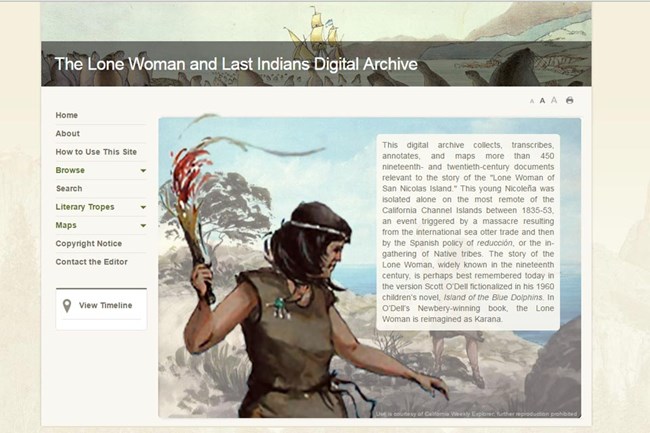
Visit the digital archive at:
http://lonewoman.ischool.illinois.edu/lonewoman
The Lone Woman and Last Indian Digital Archive collects, transcribes, annotates, and maps more than 450 nineteenth- and twentieth-century documents relevant to the story of the Lone Woman of San Nicolas Island. This young Nicoleña lived alone on the most remote of the California Channel Islands between 1835-53, a situation triggered by a massacre resulting from the international sea otter trade and then by the Spanish policy of reducción, or the in-gathering of Native peoples. The story of the Lone Woman, widely known in the nineteenth century, is perhaps best remembered today in the version Scott O’Dell fictionalized in his 1960 children’s novel, Island of the Blue Dolphins. In O’Dell’s Newbery-winning book, the Lone Woman is reimagined as Karana.
The archive presents both a digital surrogate of each document (positioned in the left pane) and an annotated transcription (positioned in the right pane). Each document was marked up with TEI so as to encode all named persons, key geographical places, groups, and texts, as well as cultural tropes such as the Lone Woman figuring as a “girl Robinson Crusoe” and as “the last of her tribe.” The project was developed using the Django web framework with a MySQL database back-end. To transform the documents from their TEI encoded state into a human readable web page XSLT was used. The links generated through the XSLT transformation enable the user to simultaneously view documents alongside historical maps and a timeline. The georeferencing software MapTiler was used to add digital copies of historic maps of the California region to a Google Maps base engine.
The digital archive seeks to facilitate research on the Lone Woman as both a historical figure and as a mythic representation of the American Indian, a reimagining central to U.S. nation-building.
Editor: Sara L. Schwebel, Ph.D.
Publisher: University of South Carolina Center for Digital Humanities
Research and Development Team
- Digital Collections Manager: Rachel M. A. Manuszak
- Document Acquisition and Transcription: Caroline Blount, Sydney Cowart, Hannah Davis, Georgia Froman, Paige Kuester, Carina Leaman, Alexis Michalos
- Document Encoding: Robert Blank, Paige Kuester, Tyler Muehl, Ainsley McWaters, Rose Steptoe
- Research and Writing: Paige Kuester, Carina Leaman, Rachel M. A. Manuszak, Elizabeth A. Matthews
- Programming: Molly Carlson, Tyler Encke, Eric D. Gonzalez
- Maps: Phillip J. Allan, Molly Carlson, Sydney Cowart
- Design Consultant: Bonnie Harris-Lowe, Aidan Zanders
- Data Visualization: Molly Carlson, Aysegul Kramer
- Senior Research Consultant: Susan L. Morris, Duncan Buell, Ph.D.
Financial support for this project was generously provided by: two University of South Carolina Provost Humanities Grants, the University of South Carolina Department of English, the Center for Digital Humanities at the University of South Carolina, the Magellan Scholar Program at the University of South Carolina, the Channel Islands National Park, the Student Conservation Association/AmeriCorps internship program, the National Society of the Daughters of the American Revolution, a Carnegie-Whitney Grant from the American Library Association, Richard H. Dittman, and the Children’s Literature Association.
Image credit: detail from Louis Chorlis’ 1817 illustration of an Aleut in a kayak off the coast of St. Paul (Alaska) with sea lions on the beach and a large sailing ship in background. Alaska State Library, Louis Chorlis Photo Collection, P139-48.
Last updated: February 25, 2020
